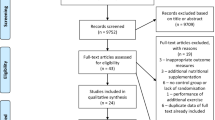Summary
The ventilatory anaerobic threshold (VAT) during graded exercise was defined as the oxygen uptake (\(\dot V_{{\text{O}}_{\text{2}} }\)) immediately below the exercise intensity at which pulmonary ventilation increased disproportionally relative to \(\dot V_{{\text{O}}_{\text{2}} }\). Since VAT is considered to be a sensitive and noninvasive measure for evaluating cardiorespiratoy endurance performance, the purpose of the present study was to determine normal values in children. We examined 257 healthy children (140 boys and 117 girls) varying in age from 5.7 to 18.5 years, during treadmill exercise. The data were analyzed in relation to sex and age. In boys the lowest \(\dot V_{{\text{O}}_{{\text{2max}}} }\) (ml · min−1 · kg−1) was found in the youngest age group (5–6 year). In girls, on the other hand, no significant increase occurred with age. For VAT, expressed as ml O2 · min−1 · kg−1 or as a percent of \(\dot V_{{\text{O}}_{{\text{2max}}} }\) a significant decrease was found in boys and girls with age. This suggests an increase in lactacid anaerobic capacity during growth. In contrast to observations in adults, only low correlations were found between \(\dot V_{{\text{O}}_{{\text{2max}}} }\) and VAT (r=0.28 in boys and r=0.52 in girls), which suggests that the development of the underlying physiological mechanism does not occur at the same rate in growing children. These data provide normal values for VAT that can be used for clinical exercise testing in the pediatric age group.
Similar content being viewed by others
References
åstrand PO (1952) Experimental Studies of Physical Working Capacity in relation to Sex and Age. Ejnar Munksgaard, Copenhagen
Bar-Or O (1983) Pediatric Sports Medicine for the Practitioner. Springer, New York
Cooper DM, Weiler-Ravel D, Whipp BJ, Wasserman K (1984) Aerobic parameters of exercise as a function of body size during growth in children. J Appl Physiol: Respirat Environ Exercise Physiol 56:628–634
Caiozzo VJ, Davis JA, Ellis JF, Azus JL, Vandagriff R, Prietto CA, McMaster WC (1982) A comparison of gas exchange indices to detect the anaerobic threshold. J Appl Physiol: Respirat Environ Exercise Physiol 53:1184–1189
Cunningham DA, Paterson DH, Blimkie CJR, Donner AP (1984) Development of cardiorespiratory function in circumpubertal boys: a longitudinal study. J Appl Physiol: Respirat Environ Exercise Physiol 56:302–307
Chandramouli B, Ehmke DA, Lauer RM (1975) Exercise-induced electrocardiographic changes in children with congenital aortic stenosis. Pediatric 87:725–730
Davies CTM, Barnes C, Godfrey S (1972) Body composition and maximal exercise performance in children. Hum Biol 44:195–214
Davis JA, Frank MH, Whipp BJ, Wasserman K (1979) Anaerobic threshold alterations caused by endurance training in middle-aged men. J Appl Physiol 46:1039–1046
Davis JA, Vodak P, Wilmore J, Vodak J, Kurtz P (1976) Anaerobic threshold and maximal aerobic power for three modes of exercise. J Appl Physiol 41:544–550
Eriksson BO (1972) Physical training, oxygen supply and muscle metabolism in 11–13 year old boys. Acta Physiol Scand 384:[Suppl] 1–48
Eriksson BO, Koch G (1973) Effect of physical training on haemodynamic response during submaximal and maximal exercise in 11–13 year old boys. Acta Physiol Scand 87:27–39
Gadhoke S, Jones NL (1973) The response to exercise in boys aged 9–15 years. Clin Sci 37:789–801
Gaisl G, Buchberger J (1980) Determination of the aerobic and anaerobic threshold of 10–11 year-old boys using blood-gas analysis. In: Berg K, Eriksson BO (eds) Children and exercise IX. University Press, Baltimore, pp 93–98
Gollnick PD, Armstrong RB, Saubert CIV, Piekl K, Saltin B (1972) Enzyme activity and fiber composition in skeletal muscle of untrained and trained men. J Appl Physiol 33:312–319
Ilmarinen J, Rutenfranz J (1980) Longitudinal studies of the changes in habitual physical activity of school children and working adolescents. In: Berg K, Eriksson BO (eds) Children and Exercise IX, University Park Press, Baltimore, pp 149–159
Lange Andersen K, Seliger V, Rutenfranz J, Mocellin R (1974) Physical performance capacity of children in Norway; Part I. Population parameters in a rural inland community with regard to maximal aerobic power. Eur J Appl Physiol 33:177–195
Máček M, Vávra J (1971) Cadiopulmonary and metabolic changes during exercise in children 6–14 year old. J Appl Physiol 30:202–204
Reybrouck T, Ghesquiere J, Cattaert A, Fagard R, Amery A (1983) Ventilatory thresholds during short and long-term exercise. J Appl Physiol: Respirat Environ Exercise Physiol 55:1694–1700
Reybrouck T, Weymans M, Ghesquire J, Van Gerven D, Stijns H (1982) Ventilatory threshold during treadmill exercise in kindergarten children. Eur J Appl Physiol 50:79–86
Reybrouck T, Weymans M, Stijns H, Van der Hauwaert L (1985) The use of the ventilatory anaerobic threshold in the evaluation of exercise performance in children with congenital heart disease and a left-to-right shunt. Ped Cardiol [in press]
Rutenfranz J, Lange Andersen K, Seliger V, Klimmer F, Berndt I, Ruppel M (1981) Maximum aerobic power and body composition during the puberty growth period. Similarities and differences between children of two European countries. Eur J Pediatr 136:123–132
Sas Institute, Inc (1982) Sas users guide: statistics. Cary, North Carolina
Stuart HC, Meredith HV (1946) Use of body measurements in the school health program. Am J Publ Health 36:1365–1386
Thorland WS, Sady S, Refsell M (1980) Anaerobic threshold and maximum oxygen consumption rates as predictors of cross country running performance. Med Sci Sports Exerc 12:87
Wasserman K, Whipp B, Koyal NS, Beaver WL (1973) Anaerobic threshold and respiratory gas exchange during exercise. J Appl Physiol 35:236–243
Weber G, Kartodihardjo W, Klissouras V (1976) Growth and physical training with reference to heredity. J Appl Physiol 40:211–215
Weltman A, Katch V, Sadey S, Freedson P (1978) Onset of anaerobic metabolism (anaerobic threshold) as a criterion measure of submaximum fitness. Res Q 48:218–227
Whipp BJ, Mahler M (1980) Dynamics of pulmonary gas exchange during exercise. In: West BJ (ed). Pulmonary gas exchange, II. Academic Press, New York, pp 33
Author information
Authors and Affiliations
Rights and permissions
About this article
Cite this article
Reybrouck, T., Weymans, M., Stijns, H. et al. Ventilatory anaerobic threshold in healthy children. Europ. J. Appl. Physiol. 54, 278–284 (1985). https://doi.org/10.1007/BF00426145
Accepted:
Issue Date:
DOI: https://doi.org/10.1007/BF00426145




